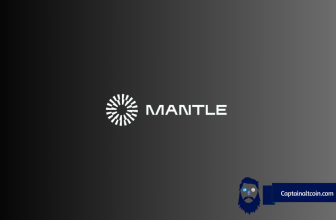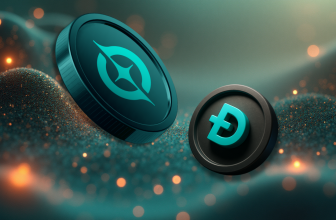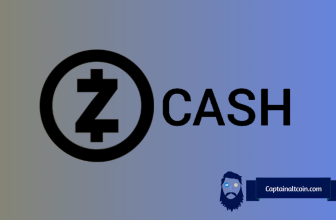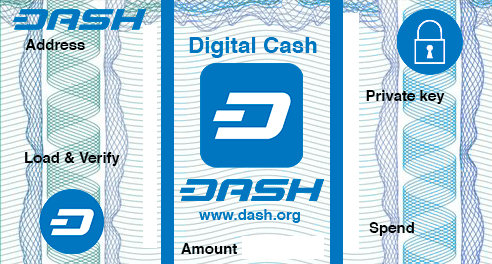
You are all probably familiar with Bitcoin, the cryptocurrency that’s taken the world by storm. General interest in cryptocurrency has skyrocketed ever since Bitcoin passed the $1,000 price mark in January 2017.

One of the beneficiaries of that interest is Dash, a cryptocurrency that’s based on the Bitcoin code.
What you'll learn 👉
What is Dash cryptocurrency?
This cryptocurrency has been around in some form since 2014. There are no centralized controls over the ‘currency’, and they are generated by miners who are rewarded with new Dash when they ‘mine’ a block of transactions, and not by a government or a bank.
Dash is essentially just like Bitcoin. However, it also has some improvements that allow it to solve some of the issues that have plagued Bitcoin for a while now.
With Bitcoin, transactions are published to the blockchain and you can prove who made them or to whom. However, with Dash the anonymization technology makes it impossible to trace them, which is important because the blockchain is accessible to anyone with an internet connection.
This is a significant drawback for those don’t wish their transaction history and balances to be publicly available. Dash does this through a mixing protocol utilizing an innovative decentralized network of servers called Masternodes. Thanks to this, Dash is avoiding the need for a trusted third party that could compromise the integrity of the system.
A more detailed comparison between DASH VS bitcoin can be found in this article.
Dash transactions are almost instantly confirmed by the Masternodes network, which is an important improvement on Bitcoin’s system. In Bitcoin’s system confirmations take much longer because all the work is done by the miners.
Dash has also implemented a decentralised governance system through utilising the masternode network, which allows masternodes to vote on important issues and budgeting proposals which, if passed, are funded directly from the blockchain. This is done through the splitting of the block rewards between budget proposals (10%), masternodes (45%) and miners (45%). This system is referred to as decentralised governance by blockchain and is the first of its kind.
Compare that to the fee distribution of Bitcoin’s block rewards – The miner receives 100%, 0% goes to Bitcoin development, and the full node operator receives 0%.
The 10% fee allocation is a big advantage according to Dash developers. Dash can fuel its growth directly from its blockchain instead of relying on community donations.
Who Created Dash?
Dash was created in January of 2014 from a fork of the Bitcoin Code by Evan Duffield. It was released as “XCoin” initially and in February of the same year, it was rebranded as DarkCoin. Finally in March of 2015, the words “Digital Cash” were shortened to just “Dash”.
Evan Duffield did this after coming to the realization that the Bitcoin devs would never accept his code, and the reason is that the changes required to the core protocol would have been unacceptable to them. One more thing worth noting is that Dash took away 1% of all daily cryptocurrency trade volume in March of 2016.
From Where Does Dash Derive Its Value?
Just like Bitcoin, Dash is fully decentralized and its value comes not from tangible assets but from mathematics. There is a formula or algorithm which dictates when and how Dash is created. The software is open-source, which means that anyone can run it, and anyone can check it.
Dash Has Grown Explosively in 2017
The price of Dash has generally stayed below $10 from 2014 to the end of 2016. However, at the turn of 2017 that changed.
Dash’s price sat at $11 on January 1, 2017.
The price had broken the $100 mark by mid-March.
By mid-June, Dash passed $200…..
….. and it reached the $770 mark in late November, only to top that in December 2017 by reaching an incredible value of $1642 per coin.
It has since slumped down to the lowly double figure value, well below $100 mark.
Is There Such Thing as a Master Private Key for the Dash Ecosystem?
There is a key that can enable or disable some of a limited list of coin features, using a mechanism called “sporks”. When Dash developers add features with a new version, they leave the feature disabled until network adoption has stabilized. If the new code causes problems it can be disabled again by the spork mechanism, and recent blocks re-validated. This prevents accidental chain splits due to bugs or unanticipated attacks.
Dash has indicated that it plans to migrate the spork mechanism to be controlled by masternodes, which would eliminate the already narrow possibility of misuse of this tool.
How to Get a Dash Debit Card
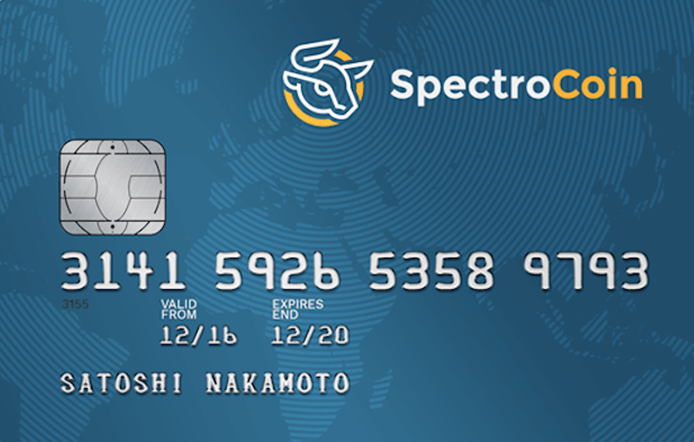
SpectroCoin offers Bitcoin prepaid cards, which can be used at shops as an ordinary payment card or at any automated teller machine (ATM) around the globe.
The great thing about the SpectroCoin VISA Debit Card is that is funded instantly. This means that you do not have to worry about exchanging your Bitcoins in advance.
One more thing worth noting is that the card can be denominated in pounds (GBP), Euros (EUR), or US dollars (USD).
You can pay with Bitcoins wherever you want. You can use your SpectroCoin Bitcoin debit card anywhere in the world where VISA or MasterCard is accepted. That includes physical shops, online sites, and ATMs for cash withdrawal. Another great feature about this Bitcoin debit card is that it can also be linked to PayPal or any other online wallet.
Physical and virtual Bitcoin debit cards are also available. Physical Bitcoin cards can be used to spend Bitcoins anywhere physically and online. They are delivered within 1-4 weeks. Virtual Bitcoin cards can be used to spend Bitcoins anywhere online. They are issued instantly.
No verification is required. You are not obliged to complete verification immediately. However, you will have to verify your account to benefit from higher debit card limits.
Instant loading. Bitcoin debit cards can be loaded instantly from SpectroCoin wallet.
Bitcoin debit cards in several currencies are available. GBP (pound), EUR (euro), and USD (US dollar) cards are issued.
Low fees are guaranteed for SpectroCoin Bitcoin debit card holders, and there is also no loading fee. The pound, euro or US dollar denominated debit card costs 6 GBP/8 EUR/ 9 USD respectively.
Multiple digital currencies. This Bitcoin debit card can be funded with various digital currencies, including DASH, Bitcoin and more.
Unlimited lifetime deposits and withdrawals to the Bitcoin debit card for verified cardholders, and other limits are also high.
Masternodes and Proof-of-Service
In addition to traditional PoW rewards for mining Dash, users are also rewarded for maintaining and running special servers called masternodes.
What are Masternodes?
Simply put, Masternodes are full nodes — computers that contain the full blockchain of a cryptocurrency and enforce rules of the network.
Most people are familiar with the single-tier network that Bitcoin utilizes, where users broadcast transactions to the network, and when miners discover a new block, they incorporate all those transactions into the blockchain.
Each block that is added to the blockchain is considered one “confirmation”. However, transactions are not considered to be fully “cleared” and irreversible until they receive at least six confirmations. With an average blocktime of 10 minutes, Bitcoin transactions take around 60 minutes to fully confirm!
Dash takes things a step further by utilizing an innovative two-tier network called the masternode network. The first tier works in the same way as Bitcoin and is composed of nodes — computers that communicate with one another within the network. Miners find blocks and post transactions to the blockchain. The second tier is comprised of special servers called Masternodes, and enables additional features such as decentralized governance and budgeting, private transactions (Darksend), and instant transactions (InstantX). Masternodes facilitate specialized transactions for InstantSend and PrivateSend, and they also control the development of the Dash network.
Anyone can run a Masternode, but in order to do so, you need to have 1,000 Dash available as collateral. This is to prevent so-called “Sybil attacks” on the network. The 1000 DASH is not locked or consumed, and it can be moved or spent at any time by the user. However, doing so will result in the Masternode turning itself off.
In theory, requiring masternode operators to post collateral helps protect the network, because If someone wanted to attack the Dash network, they would first need to purchase a substantial amount of Dash to become a masternode operator. However, this means that it wouldn’t make any sense to attack the Dash network, because doing so would destroy all their holdings. Masternode operators have an incentive to protect the Dash ecosystem because they have invested a lot in the network.
People are incentivized to run Masternodes because they receive a portion of the reward when miners find new blocks (the masternode operator receives 45% of the block reward, the miner receives 45%, and the Dash maintenance fund receives 10%). The return on investment is currently around 15% (you will earn approximately 150 DASH over the course of a year from running a Masternode).
Currently, around 4,500 masternodes are on the Dash network in 22 different countries, which provides a high level of decentralization due to the impossibility of one user gaining control of enough Masternodes to deanonymize transactions. In comparison, there are currently about 9,000 nodes on the Bitcoin network.
Masternodes are usually hosted on virtual private servers (VPS) run by companies such as Vultr, Microsoft Azure, Amazon Web Services, and others.
What is X11 Chained Hashing Algorithm?
Created by Dash lead developer Evan Duffield, X11 is a widely used hashing algorithm that utilizes a sequence of eleven hashing algorithms for the proof-of-work (PoW). This is designed to increase the decentralization level of the currency by making ASICs much more difficult to make for these algorithms (it would take years).
With chained hashing, high end CPUs give an average return similar to that of GPUs, and GPUs require approximately 30% less wattage and run 30-50% cooler than they do with Litecoin’s Scrypt algorithm.
What is PrivateSend?
PrivateSend (formerly known as DarkSend) is the feature that gives Dash users full privacy when they use it. It is a coin-mixing service based on CoinJoin, with numerous modifications including strong anonymity by using a chaining approach, decentralization, denominations and passive aheadoftime mixing.
You gain the ability to keep the currency itself perfectly fungible by having a decentralized mixing service within the currency. At the same time, any user is able to act as an auditor. He/She can guarantee the financial integrity of the public ledger without compromising others privacy.
This feature uses the fact that a transaction can be formed by several parties and made out to several parties to merge funds together in a way where it is impossible for them to be uncoupled thereafter. Given that all Darksend transactions are setup for users to pay themselves, user’s coins always remain safe because the system is highly secure against theft. Currently, at least 3 participants are required to mix using PrivacyProtect.
They propose using common denominations of 0.1DASH, 1DASH, 10DASH AND 100DASH to improve the privacy of the system as a whole. All users should submit the same denominations as inputs and outputs in each mixing session. Also, fees should be removed from the transactions and charged in bulk in separate, sporadic unlinkable transactions.
The maximum allowed for a PrivateSend transaction is 1000 DASH. It requires multiple sessions to thoroughly anonymize significant amounts of money. PrivateSend runs in a passive mode to make the user experience easy and make timing attacks very difficult. A user’s client will request to join with other clients at set intervals via a Masternode. A queue object is propagated throughout the network upon entry into the Masternode, detailing the denominations the user is looking to anonymize, but no information that can be used to identify the user. Each PrivateSend session can be thought of as an independent event. This increases the anonymity of user’s funds. However each session is limited to three clients. This means that an observer has a one in three chance of being able to follow a transaction. To increase the quality of anonymity provided, a chaining approach is employed, which funds are sent one after another through multiple Masternodes.
The Dash client stores pre-mixed, denominated Dashs in the user’s wallet. They can be used instantly at any time the user wishes. The mixing and denomination process is automatic, seamless, and it doesn’t require intervention on the part of the user. Here’s how it works:
All user clients network-wide will send any unmixed Dash in their possession every 10 blocks, through an anonymization phase. Masternodes are used in this phase in chained succession to mix the coins that they receive from the network and break them down into homogenous denominations. After being processed by a minimum of two Masternodes, the coins are either sent back to the user’s wallet at randomly generated change addresses or to the next Masternode in the chain.
It’s important to note that at no point in the process do a user’s coins ever leave his/her control. They will be sent to different addresses within the wallet. However, they never leave the user’s possession.
Users may select between two and eight “rounds” of mixing, depending on the desired level of privacy. One more thing worth noting is that the desired mixing depth can be selected in the client GUI.
The user’s coins are returned to their client at the end of the anonymization phase at a randomly generated change addresses, and when the user wants to make a transaction, the client forwards the intended amount from these anonymous change addresses directly to the intended receiver’s address.
Getting Started With Dash
What is Decentralized Governance by Blockchain (DGBB)?
Although there has been a lot of hype around The DAO (Decentralized Autonomous Organization), Dash is the first of such a construction and it has developed a decentralized system to govern and fund the future development of the project. It is Sybil-attack-proof decentralized governance and funding system, which means that it is impossible to game the system by creating multiple pseudonymous nodes to gain more control over the network artificially than one user was intended to have. This means that money can be spent in a decentralized fashion based on network consensus.
Anybody can come up with a project to help develop the Dash ecosystem, submit it to the network and each masternode owner is given a single vote. The proposal will then be voted on by Masternode owners and if approved by at least 10% of the network’s Masternodes, the funds will be automatically disbursed when the next super block is released the following month.
Every time a miner solves a block, 45% of the block reward goes to the miner. 45% goes to Dash Masternode operators. 10% of the block reward is not created at that time – it is withheld by the Dash network and set aside for DGBB proposals. Once a month the DASH that was withheld is created by “superblocks,” and these blocks, one per approved proposal, create the DASH needed to pay the proposals. Dash’s emission rate doesn’t change, because the same amount of DASH is created.
- Get a DASH Wallet.
- Buy Some DASH (on Cex.io, Coinmama or Binance)
- Use Your DASH.
- Stay Up-to-Date.
What is InstantSend?
InstantSend (formerly known as InstantX) is the technology that allows for transactions to be fully confirmed in only four seconds. This technology uses the second tier of the Dash network (Masternodes) to produce a “lock” once a transaction is created on the network, and the DASH involved in that transaction are locked and cannot be double-spent. Any attempts to spend the locked DASH again will be rejected by the network
Dash Advantages
Instant Payments
Bitcoin and most other advanced monetary standards are quick with respect to bank exchanges. However, they set aside a lot of opportunity to affirm exchanges on their system. On account of Bitcoin, it takes a normal of 10 minutes to affirm an exchange. Also, many traders require 5-6 affirmations before considering the exchange finish.
This 50-hour long exchange time might be satisfactory for making instalments on the web. However, this makes about every single computerized cash illogical for things like up close and personal or in-store purchases and could restrain their potential.
The people at Dash designed an exceptional, decentralized innovation called InstantSend that affirms instalments in about 4 seconds. I know it’s difficult to believe, but it’s true. Money can be sent to wherever on the globe in just a couple of moments!
Low Expense
With Dash, expenses are much lower than Visas or banks. Often there is no expense. You can send miniaturized scale instalments anyplace on the planet and you don’t get charged a ton to utilize your own money.
Two-Tier Network
Dash is the principal digital money to present the idea of “masternodes”, which are servers associated with the Dash. Today, these servers are utilized to offer clients protection and moment exchanges.
Later on, they can be utilized to acquaint new administrations with the system. This is the feature that other digital forms of money can’t convey. This two-level system additionally guarantees that Dash gives an abnormal state of administration to its clients, which helps it remain an exceptionally hearty framework.
Expanded Privacy
Digital forms of money utilize an open record where exchanges can be checked by anybody as they happen. General society record idea is truly imperative. The certainty that people have in the framework, originates from the way that everyone on the system goes about as a reviewer to confirm that the framework is working precisely as planned.
With advanced monetary forms like Bitcoin, people send and get money utilizing “open keys” or “locations”. The way the Bitcoin addresses appear to people who are unfamiliar with cryptography is one of the main obstacles that prevents mainstream adoption of Bitcoin. These addresses comprise of a series of characters and here’s a sample Bitcoin address:
XrEgRgW6JkrsY38QGV65rnmKBRZ7KSRktv
Clients don’t utilize their name (this is known as a pseudonymous framework). However, after some time numerous sellers, administrations, trades, and people that clients execute with can append your own data to your address.
Once your character has been related with your address, that important data can be utilized to track your spending, pay, and other exchange exercises. It can be even sold to others, for example charge specialists, culprits, advertisers, law implementation, or notwithstanding snooping relatives. For example, if you send money to anybody, that person can connect you with your whole exchange history.
Dash sees budgetary protection as a major right and it made a possibility for clients to make exchanges with genuine protection, so no one would ever connect a client’s character with a specific exchange or address. Clients can keep every one of their exchanges private thanks to Dash.
Shared
As of not long ago, if you wanted to exchange your assets, you were absolutely subject to banks, and they have the ability to obstruct your record, debase, or even appropriate your money. Today, thanks to Dash you have a decision. With Dash, every one of your assets is controlled by your own wallet and all cash exchanges are controlled and confirmed by a conveyed arrange. The decentralized system of clients all around world disposes of the requirement for delegates as well as their charges.
Very Much Defined Governance Model
Great administration and administration of a crypo-cash venture is imperative to everybody. This includes even the individuals who are not actually slanted. For example, Bitcoin is completely reliant on wilful commitments from private industry and foundations in spite of being the most prevalent and best-financed digital currency.
Because of this, Bitcoin has been left powerless against the impulses of these organizations for proceeded with help. Also, genuine differences among its engineers about specialized parts of Bitcoin’s answer do not have a very much characterized way to determination. This prompted worry in the media over the task’s heading and capacity to beat question.
It’s important to note that Dash has a very much characterized set of instruments for anybody to try to improve Dash by submitting recommendations to the system, get endorsement, and store those recommendations straightforwardly from the system’s income. There are a few reasons why is this critical to end-clients. To begin with, it guarantees that Dash is free from the impacts of key promoters. This allows it to concentrate on conveying its centre mission to its clients.
Second, regardless of the possibility that the advantages are generally spread over the system, it empowers every meriting venture or enhancements the chance to be subsidized. Third, it gives a way to determine disagreements about the future advancement of the innovation. This guarantees coherence of the system’s administrations. We strongly believe that the Dash administration instruments will advantage its clients by conveying a predominant arrangement.
Worldwide Payments and Infrastructure
Cash can be exchanged anyplace, to any individual who has a Dash wallet, and these exchanges can’t be hindered or followed by outsiders.
Security
Dash is your very own computerized money. It is ensured by utilizing propelled cryptography. Exchanges are prepared by the conveyed energy of thousands of free PCs all around the world.
Dash works on a protected, decentralized system. Its essential leverage is the two-level engineering of its system. Dash’s source code is open and accessible to be seen and verified by anybody, which ensures the wellbeing, autonomy, and security of the framework.
New Business Possibilities
Advanced monetary standards like Dash are opening another universe of business openings. That’s why it is very important to be comfortable with this innovation.
The improvement of overall advanced monetary standards opens up numerous open doors either to give foundation and administrations straightforwardly identified with Dash or just to be comfortable with the way it works and offer it as an esteem added alternative to clients in any customary business.
Dash is a pioneer in digital currency development. It is the first to work in security highlights, momentary exchanges, and various other imaginative highlights. We strongly believe that it is extremely important to be acquainted with the new energizing innovation, hold some computerized money, figure out the fact that it is so natural to utilize a wallet to send and receive money, and new thoughts will come up about how this innovation can be applied to your everyday life.
Less demanding International Trade
Computerized monetary standards comprehend many wasteful aspects in the budgetary framework, for example, encouraging electronic instalments and global cash exchanges for little sums. On the other hand, Visas and wire exchanges are restrictively costly for these things. Computerized monetary standards unite people in a world that is quickly cutting separations and takes into consideration more worldwide collaboration free of neighbourhood cash or a man’s area.
Early Adopter Advantage: Investment Potential
Dash’s future looks encouraging. Also, Dash gives many highlights that are extremely valuable for people all around the world. Being an early adopter offers ascend to the likelihood that after some time, your Dash property could develop in an incentive. There is, obviously, a danger of value changes. However, when contrasted with other cryptographic forms of money, Dash has turned out to be extremely steady.
How to Get a Dash Wallet?
Guide for Dash Wallet in Linux
Video: https://youtu.be/DJZG6l6KRDM
Guide for Dash Wallet in Mac
Video: https://youtu.be/hCGZPN0Sb84
Guide for Dash Wallet in Windows
Video: https://youtu.be/yLjPUVkMlD8
Guide for Dash in Electrum Wallet
Link: https://electrum.dash.org/
The Electrum-Dash client focuses on speed, with a simple interface and low resource usage. It operates in conjunction with high-performance servers that handle the most complicated parts of the Dash system, so startup times are almost instant.
Electrum-Dash is a lightweight Wallet. This means that you do not need to download or sync the blockchain, which significantly speeds up use of the wallet. However, it is missing many key Dash features available in Dash Core, including:
- Voting
- Masternode control
- InstantSend
- PrivateSend
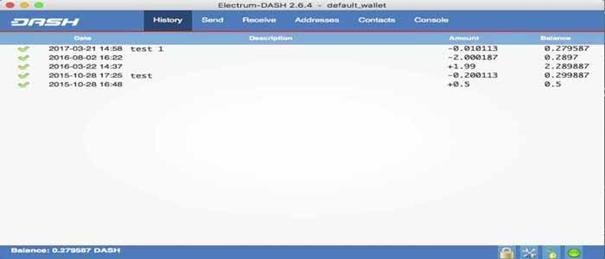
WARNING: As with all software, it’s highly recommended to only download from the official Electrum-Dash page.
Windows installation:
Download the file labelled “Windows Executable” and run it.
Mac installation:
Video: https://youtu.be/HdnYTuL_JUk
Linux installation:
Download the file labelled “Linux Source Tarball” and run the following commands in the terminal:
sudo apt install python-pip python-qt4 libusb-1.0-0-dev libudev-
dev
pip install ./Downloads/electrum-dash-2.6.4.tar.gz
electrum-dash
Receive Payments
You may own Dash stored on an exchange such as Kraken or Bittrex, or in another software wallet, or simply want to receive funds as a business transaction or a wage. You can transfer funds from these sources into the Electrum wallet through one of its receiving addresses, which can be viewed by clicking the Receive tab. Double-click the Receiving address, and then click the Copy to clipboard icon to copy the address to the clipboard. You can also enter a description click Save to store the address in the Requests list if you intend to use the address repeatedly. Clicking an address in the list will display the stored information in the top area. It will also display a QR code containing the same information.
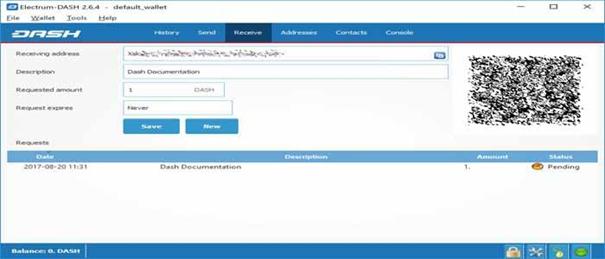
Enter this address in the software sending the funds (https://www.weusecoins.com/video-qa-where-are-the-exchange-traded-funds/). After that, send it to the person transferring funds to you or scan it directly from your mobile wallet. The balance will appear in the lower left corner of your wallet once the transaction is complete. Also, the indicator in the Requests table will change from Pending to Paid.
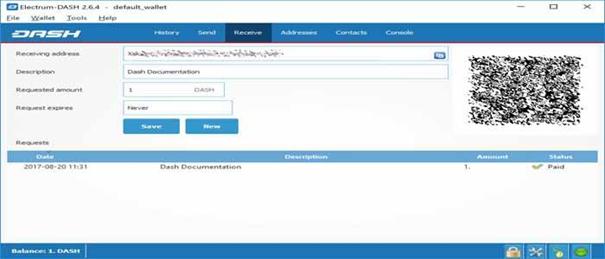
Once you have used an address, you can either click New to generate a new address or continue using the same address.
Hardware Wallets
You can store your Dash on specialized cryptocurrency wallets, such as TREZOR, Ledger Nano S and KeepKey.
Check the comparison below:
Video: https://youtu.be/aOnOBl_MxmQ
Mobile Wallets
Dash offers a standalone wallet for Android, which is designed to securely implement the latest features. Dash is also supported by several third-party apps. Look for wallets like:
- Jaxx on iOS (https://itunes.apple.com/us/app/jaxx-blockchain-wallet/id1084514516)
- Dash Wallet by Dash Foundation (https://itunes.apple.com/us/app/dash-wallet/id1206647026)
- iOS Wallet
- Coinomi
- Jaxx on Android (https://play.google.com/store/apps/details?id=com.kryptokit.jaxx)
- Dash Wallet (https://play.google.com/store/apps/details?id=hashengineering.darkcoin.wallet)
How to Buy DASH?
Buy Dash with a Wire Transfer
Kraken – This is a well respected altcoin exchange that allows you to fund your account with EUR or USD through a wire transfer and then purchase Dash directly.
BitPanda – It allows you to buy Dash using your credit card, SOFORT transfer, SEPA transfer and Skrill account. You have to go through a verification process if you buy Dash via Bitpanda. BitPanda is available only in Europe and offers you relatively low buying limits (600 Euros).
AnyCoinDirect – They are the biggest cryptocurrency exchange in Europe and they make it relatively easy to buy Dash directly through a SEPA transfer for customers who are located in Europe. It is important to note that their fees aren’t overly expensive. After being verified, it takes only a couple of days to receive your Dash.
Buy Dash Directly with Cash
WallofCoins – Users can buy Dash at close spot cost by basically keeping money at a nearby bank in many countries like the United States, the Philippines, Latvia, Poland, Brazil, Germany, and Canada.
A talk with client bolster uncovered that, since they are an escrow benefit, they can offer Dash at almost the going business sector rate. By offering this escrow benefit, they can encourage a fiat to digital money exchange moderately and send Dash directly to buyers quickly.
It takes around 15 minutes to get Dash after money store confirmation. Taking all the things into consideration, people who need to buy Dash directly with cash can do so for about a 1% charge, while abstaining from buying Bitcoin first. It’s important to note that people who need to purchase Bitcoin, can likewise do so at WallofCoins, rearranging the way toward purchasing digital money generously.
Dash ATMs – There are three areas in the United States, where clients can buy Dash directly from an ATM – in Oregon, Florida, and New York. The expenses are high. However, this is one of the most effortless approaches to secure Dash. Check CoinATMRadar to find the ATM areas where BTC and different digital currencies can be bought.
Exchange Bitcoin for Dash
If you’ve already bought Bitcoin, moving it to one of the main exchanges like Bitfinex, Poloniex, Kraken, Changelly, or ShapeShift allows you to easily trade Bitcoin for Dash.
How Dash Can Be Earned?
Passive Income Using Dash Masternode on Raspberry Pi
The big question is, why would you want to earn passive income as a Dash Masternode?
First, one can get up and running with just a Raspberry Pi, which is inexpensive and small. Second, the ROI (return-on-investment) is estimated currently to be at 17 % per year.
The Dash blockchain has set itself apart as the only currency in the world to incentive its nodes with regular payment. Masternodes earn 47.5 % of the Dash block reward. This puts their earnings on par with Dash’s miners.
It is important to note that you too can join the savvy group of earners running a Dash Masternode on a Raspberry Pi. All you need is some initial collateral and about $50 to invest in hardware.
Pi Time
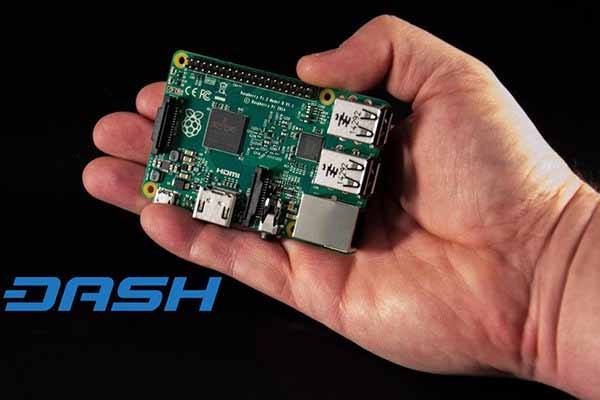
We interviewed two current Masternodes operators – Mangled Blue and Fuzzyduck – about their recommendations, costs, and setups. They both use the Raspberry Pi 2, which costs around $40, and they’ve added to it an $8 microSD card (8GB).
Fuzzyduck explains that the Raspberry Pi 1 only had 512MB of RAM. However, this may not have been enough to run a Masternode. But the Raspberry Pi 2 does the trick since it boasts a full gigabyte of RAM. He says:
“At the moment, my Pi2 is running super-stable, and I would like to see more people just try it. I hope it remains this way for the coming versions.”
Mangled Blue says that he also used a USB mouse, a USB keyboard, HDMI monitor, and an HDMI cable. He explains that you can use a cell phone charger for power, or a microUSB-b to USB cable. Lastly, he connects his Pi with an Ethernet cable to his Internet modem. He concedes that Wi-Fi could work, but he doesn’t recommend using it. He adds:
“I might not know every little detail about DASH or other cryptos. However, having a Masternode keeps me involved, and also forces me to learn something new. I have to admit that I knew nothing about Linux this time last year.”
Collateral
A collateral of 1,000 Dash is required in order to run a Masternode, and this amount remains in the user’s possession. At any time, the user can rescind their Masternode status by reclaiming their collateral.
The collateral scheme is designed in such a way to make a malicious takeover of the network (a “51 % attack”) cost-prohibitive for an attacker. It also has a side benefit of stabilizing Dash’s price. This feature makes Dash more attractive as a currency.
You are Interested in running a Masternode. However, you don’t have the full collateral amount? Don’t worry. “We can find you people to pair up with if you don’t have the 1,000 Dash required – that’s how I got started,” says Mangled Blue. “There are many great people and infos in the forums to get you up and running.”
Earnings
“I have been running the Masternode stable for months now, and I can definitely say that it already paid for itself!” says Fuzzyduck. “Current price is $3 per Dash, and my Pi2 cost around $35. Every four days I earn three Dash. Do the math.”
And the payout isn’t Fuzzyduck’s only perk. He continues, “We are all technerds. This means that we love to tinker with hardware and software – just for the fun of it! If I can do it, you can do it too.”
Proper Security & Risk Management
Dash Talk user Flare chimed in on security, and he says:
“Running a publicly accessible host always requires security measures. The same security rules that apply for a VPS also apply for a home-run Pi (e.g. disable remote root login and enable firewall).”
And in the event that your home network is breached, your 1,000 Dash collateral is still safe. This is because neither a Pi nor a VPS ever stores your private keys.
Fringe Benefits
It is important to note that a Dash Masternode does more than just provide paid services to the network. Each new node also adds to Dash’s decentralization. This is a key component for any peer-to-peer operation that aims to achieve resilience and staying power.
Just how decentralizing are Dash’s Masternode incentives already? Check these numbers: There are currently about 9,000 nodes on the Bitcoin network and Bitcoin’s market cap is nearly US$4 billion. In contrast, Dash’s market cap is only US$17 million – a mere half a percent of Bitcoin’s market. However, around 4,500 masternodes are on the Dash network in 22 different countries and counting.
What Is Dash Mining?
Dash uses a special algorithm for the proof-of-work (PoW) called X11, which is one of the innovations introduced by Dash and has been widely adopted in the cryptocurrency community since its launch.
The features of X11 make it extremely unlikely that ASICs will be developed to mine it.
Mining refers to the process of searching for solutions to cryptographically difficult issues as a method of securing blocks on the blockchain. Mining is possible on a range of hardware, and the process of mining creates new currency tokens as a reward to the miner. Dash implements an algorithm known as X11. The miner must solve this algorithm in order to earn rewards.
The general purpose CPU is the simplest and most general hardware available for mining. It is present in every computer, and is designed to be versatile. However, it offers less efficiency than a GPU, which is designed to quickly calculate millions of vectors in parallel. Specific CPU instruction enhancements related to cryptography such as AVX or AES can provide a decent increase. However, GPUs offer a huge performance boost due to their multiple pipelines for predictable calculations of the type involved with mining.
One more thing worth noting is that ASICs can only perform a single operation. There are a number of X11 ASICs that are currently available on the market. This is rapidly making CPU and GPU mining uneconomic because of the increased difficulty of hashing arising from the rapidly increasing hash rate, and the result is a currency that is more secure against brute force attacks on the Dash blockchain.
Mining vs. Masternodes
Dash is based on a decentralized ledger of all transactions, known as a blockchain. This blockchain is secured through a consensus mechanism. The consensus mechanism is Proof of Work (PoW) in the case of both Dash and Bitcoin. Miners try to solve difficult problems using specialized computers, and they receive the right to add a new block to the blockchain when they solve the problem. The block is added to the blockchain and the miner is rewarded if all the other people running the software agree that the problem was solved correctly.
However, because Dash has a two-tier network, it works a little differently from Bitcoin. The second tier is powered by masternodes (Full Nodes). They enable instant transactions (InstantSend), financial privacy (PrivateSend), and the decentralized governance and budget system.
Masternodes are also rewarded when miners discover new blocks because this second tier is so important. The breakdown is as follows: 10% of the block reward is reserved for the budget system (created by superblocks every month), 45% goes to the miner, and 45% goes to masternodes.
Since the masternodes provide crucial services to the network, the masternode system is referred to as Proof of Service (PoSe). In fact, the entire network is overseen by the masternodes. They have the power to reject improperly formed blocks from miners. If a miner tried to run an old version of the Dash software or to take the entire block reward for themselves, the masternode network would orphan that block, and it would not be added to the blockchain.
In short, masternodes power the second tier, which provide the added features that make Dash different from other cryptocurrencies, while miners power the first tier, which is the basic sending and receiving of funds and prevention of double-spending. It is important to note that masternodes do not mine. Also, mining computers cannot serve as masternodes.
Additionally, each masternode is “secured” by 1000 DASH, which remain under the sole control of their owner at all times, and can still be freely spent. The funds are not locked in any way, but if the funds are spent or moved, the associated masternode will go offline and stop receiving rewards.
CPU Mining
Now it’s time to hash the Dash using your CPU cores to find X11 solutions on the Windows platform! It’s important to note that the prevalence of GPU and ASIC miners mean that this is not very likely to be profitable! Since this is the case, the software in this guide is intended for experimental purposes only, and has not been updated in several years.
This is a fairly simple procedure. Examples will be given in order to achieve the quickest possible hash rate for your CPU. However, you should know that more optimized miners do exist. That’s why it is highly recommended to keep an eye out on mining sites such as these in order to keep up with the newest information and releases.
Mining Software
You will need software, and this is a good starting place:
This software depends on your CPU supporting the AES-NI and AVX instruction sets, and you can use CPU-Z to check if this is the case for your CPU:

What should I do if my CPU does not support AES-NI and AVX? You can try more generalized software that does not require specific instruction sets, such as these:
Our goal here is to try to increase the hash speed by choosing mining software that supports the maximum possible instruction sets available on your CPU.
Once you have made your choice, click Releases to download the zip file. When you extract the file, the folder should look something like this:

As you can see, there are different .exe files. They indicate which specific processor optimizations they support.
Mining pools
In order to find and solve blocks, you must join a team of people known as a pool. A common choice of pool runs the P2Pool software. You can find a list of Dash P2Pools here:
Other pools include:
You should choose your pool based on the ping latency, users, fee, uptime, etc. Please support P2Pool nodes if possible, because they protect the network from 51% attacks and keep mining decentralized!
In order to receive your payout, you will also need to create a Dash address. See here to do this in Dash Core wallet.
Configuration
It’s very important to keep all your mining files in a single folder. We will work from the Desktop in this example, and the node selected for this example is located in China and is from the p2poolming.us list:
After that, open Notepad and type in on one line the command we will use to start the miner, followed by pause on the second line, and the general format is as follows:
minerd -a algorithm -o url -u username -p password -t threads
pause
Where:
minerd = This is the executable miner daemon file you choose to use.
a = algorithm, for Dash it is X11.
o = URL of your mining pool, including the port and protocol.
u = username. It is usually the Dash receiving address of your wallet or worker.
p = password. It can often be set to x.
t = number of threads that are used.
pause = keeps the window open if there should be any errors
The command for the CPU in the example above may be:
minerd-avx-aes-sse2-sss3.exe -a X11 -o stratum+tcp://118.184.180.43:7903 -u XwZRjo1f6gmq3LCv7X1Hi5h3NkvDMHvu8G -p x -t 8
pause
Click File, then Save As, and then change Save as type to All Files. After that, type the file name as startminer.bat and save it as the unzipped minerd files in the same folder.

Important Tips
- You should try to select a pool that is nearby in order to reduce network latency. Switch to another location if the node appears slow.
- For added performance, tweak the processor clock speed using a motherboard controller like AI Suite for Asus motherboards. Reduction of CPU core voltage will result in lower temperature. However, it will also increase instability.
- Consider fitting a new fan if the CPU temperature is too high. Also, check that the heat sink thermal paste on the CPU is adequate.
- Reduce the number of threads for heat reduction and desktop usability.
To avoid forking, you should distribute the hashing power globally to different pools.
GPU Mining
This guide consolidates several other guides on how to use your GPU to mine Dash using the X11 algorithm on Windows. It’s important to note that the growing market for ASIC miners means that this is highly unlikely to be profitable! Also, this guide should be used for experimental purposes only because a lot of the software and binaries described here have not been updated for several years.
This guide will cover the process of downloading and configuring the mining software. There will also be some recommendations for optimizations. This technology can change rapidly. That’s why it is highly recommended to keep an eye out on mining sites such as these in order to keep up with the newest information and releases.
Mining Software
A range of mining software is available for GPU mining, and most of them are based on sgminer compiled with different optimizations specific to different hardware. It is recommended to first identify your graphics hardware, and then choose an appropriate build of sgminer. You can identify your GPU hardware using GPU-Z:
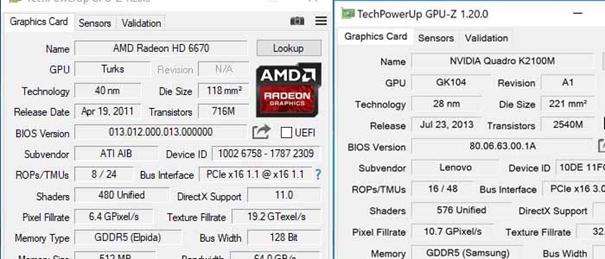
GPU-Z showing details for NVIDIA Quadro GK104 and AMD Radeon Turks.
The next step is downloading the mining software. Most of these are based on the original sgminer. However, this is not suitable for the X11 algorithm, hasn’t been updated in years and offers no compiled binaries. Here is a description of using pre-compiled binary software that is maintained by newer developers only.
AMD
- release (supports only one pool)
- https://github.com/nicehash/sgminer/releases
NVIDIA
- release (sp-mod, optimized CUDA kernels for Windows)
- releases (focus on core application)
- releases (similar to SP version, but is more clean)
Download your chosen release, extract the zip file to a known location, and here is how the folder looks like:
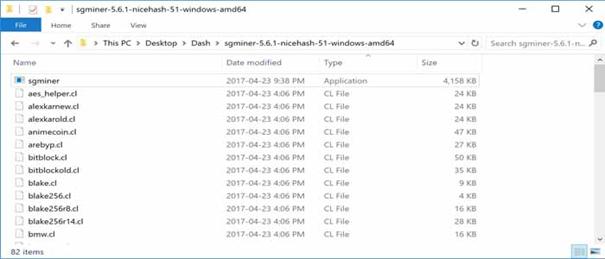
The sgminer file is the executable file. On the other hand, the various files with .cl extensions define the various algorithms supported by sgminer. We are in this case interested in the darkcoin-mod.cl and darkcoin.cl implementations of X11. It’s important to note that the executable file’s name may be different for miners with different optimizations, for instance ccminer for NVIDIA cards.
Mining Pools
In order to find and solve blocks, many people join a team of other miners, known as a pool. A common choice of pool runs the P2Pool software. A list of Dash P2Pools can be found here:
Other pools include:
You should choose your pool based on the ping latency, users, fee, uptime, etc. Please support P2Pool nodes if possible, because they protect the network from 51% attacks and keep mining decentralized!
Important Tips
- You can try to overclock your GPU to squeeze out some more performance using Afterburner if you are feeling adventurous. Note that you are doing this at your own risk. This can be done by increasing the clock rate and reducing the voltage to manage heat. Anything above 90 °C risks permanent damage to your GPU, so be aware of your maximum GPU temperature.
- If old driver versions cause you some problems, try using a Display Driver Uninstaller tool in safe mode to make sure there is no trace of previous versions.
- You can often improve performance by installing the latest display drivers, which can be found here for AMD and NVIDIA.
- Changing the graphics driver version can influence performance, for example, some report for AMD cards suggest that Catalyst 14.7-RC3 may offer improved performance.
- If you have a Crossfire setup, disable Crossfire in your ATI Catalyst settings. If you don’t do that, things will be funky.
- You can also try mining under Linux. Or, you can try compiling your own mining binary from source with specific optimisations for your hardware under either Linux or Windows.
Dash Resources
Official Website
Whitepapers
Masternode Guides:
Masternode Services (Hosting / Pooling / ….):
Full Official Page listing:
Block Explorer / Crawler:
Downloads
- Wiki + Confluence (https://dashpay.atlassian.net/wiki)
- Dash Source (https://github.com/dashpay/dash)
- Walletgenerator.net – Paper Wallet (https://walletgenerator.net/)
- Paper Wallet (http://paper.dash.org/)
- Mobile Wallets (https://dashpay.atlassian.net/wiki/display/DOC/Mobile+Wallets)
- Electrum Wallet (https://www.dash.org/downloads/)
- Windows / MacOS / Linux (https://www.dash.org/downloads/)
Facebook: https://www.facebook.com/DashPay
Instagram: https://www.instagram.com/dashpay/



